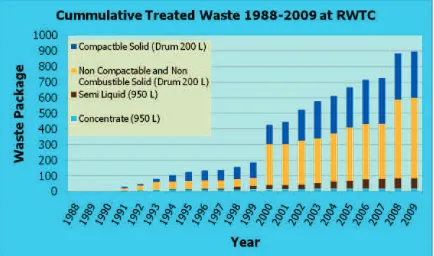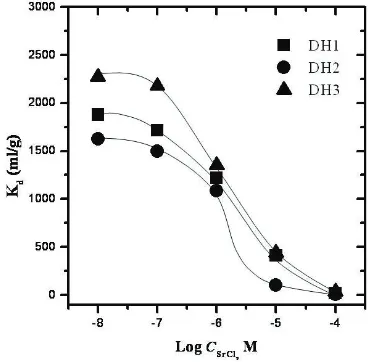Interaction of Sr-90 with site candidate soil for demonstration disposal facility at
Serpong
Budi Setiawan, Oktri Mila, and Safni
Citation: AIP Conference Proceedings 1589, 325 (2014); doi: 10.1063/1.4868811
View online: http://dx.doi.org/10.1063/1.4868811
View Table of Contents: http://scitation.aip.org/content/aip/proceeding/aipcp/1589?ver=pdfcov
Published by the AIP Publishing
Articles you may be interested in
137 Cs sorption into bentonite from Cidadap-Tasikmalaya as buffer material for disposal demonstration plant facility at Serpong
AIP Conf. Proc. 1589, 346 (2014); 10.1063/1.4868816
Interaction of actinides with aerobic soil bacteria AIP Conf. Proc. 532, 275 (2000); 10.1063/1.1292293
Dosimetry of Sr90 ophthalmic applicators Med. Phys. 17, 641 (1990); 10.1118/1.596494
Candidate muonprobe sites in oxide superconductors J. Appl. Phys. 64, 5809 (1988); 10.1063/1.342212
Interaction of Sr-90 with Site Candidate Soil
For Demonstration Disposal Facility at Serpong
Budi SETIAWAN
1*, Oktri MILA, SAFNI
21
Radwaste Technology Center-National Nuclear Energy Agency, PUSPIPTEK, Serpong-Tangerang, INDONESIA 15310 2
Dept.of Chemistry, Fac. of Math. And Nat. Sci., Andalas University, Kampus Limau Manis, Padang-West Sumatra, INDONESIA 25163
* Email: bravo @batan.go.id
Abstract. Interaction of radiostrontium (Sr-90) with site candidate soil for demonstration disposal facility to be constructed in the near future at Serpong has been done. This activity is to anticipate the interim storage facility at Serpong nuclear area becomes full off condition, and show to the public how radioactive waste can be well managed with the existing technology. To ensure that the location is save, a reliability study of site candidate soil becomes very importance to be conducted through some experiments consisted some affected parameters such as contact time, effect of ionic strength, and effect of Sr+ ion in solution. Radiostrontium was used as a tracer on the experiments and has role as radionuclide reference in low-level radioactive waste due to its long half-live and it’s easy to associate with organism
in nature. So, interaction of radiostrontium and soil samples from site becomes important to be studied. Experiment was performed in batch method, and soil sample-solution containing radionuclide was mixed in a 20 ml of PE vial. Ratio of solid: liquid was 10-2 g/ml. Objective of the experiment is to collect the specific characteristics data of radionuclide sorption onto soil from site candidate. Distribution coefficient value was used as indicator where the amount of initial and final activities of radiostrontium in solution was compared. Result showed that equilibrium condition was reached after contact time 10 days with Kd values ranged from 1600-2350 ml/g. Increased in ionic strength in solution made decreased of Kd value into soil sample due to competition of background salt and radiostrontium into soil samples, and increased in Sr ion in solution caused decreased of Kd value in soil sample due to limitation of sorption capacity in soil samples. Fast condition in saturated of metal ion into soil samples was reached due to a simple reaction was occurred.
Keywords: site candidate, soil samples, radiostrontium, sorption, Kd
PACS: 89.60.Ec
INTRODUCTION
Low and intermediate-level radioactive waste from a wide range of activities (industry, hospital, research, education etc.) comes from all part of Indonesia will be managed and treated at Radioactive Waste Technology Center in Serpong resulting waste packages in 200 L drum or 350 L and 950 L of concrete shell forms, and then are stored in an interim storage building until the facility will be fully at one time. Figure 1 shows the capacity rate of radwaste inventory at interim storage building in Serpong [1].
To anticipate the problem, the agency was prepared a location near the treatment facility called as SP-4 site to be used as radwaste disposal facility for demonstration purpose, shown in Figure 2. The existence of disposal facilities for demonstrations of radioactive waste disposal in Indonesia is expected could demonstrate the ability and mastery the technology and safety in the disposal and radioactive
waste management activities in Indonesia. As similar with other radioactive waste disposal facilities, demonstration disposal facilities are also equipped with a natural barrier and engineered barrier systems to ensure the environmental safety [2].
FIGURE 1. Number of radwaste packages at the interim storage building in Serpong.
The SP-4 site will serve as a natural barrier and has role to retard the possibility of radionuclide spreading
into environment. The existence of such role has led to soil in the site has a very important position in the preparation of radioactive waste disposal facility, and also to retard the possibility of radionuclide spreading into environment needed to be studied in detail. Also to consider, placing the disposal and processing facilities in a same area (co-location principle) as a good example of radwaste management strategy in a near future.
FIGURE 2. location of candidate site for the demonstration disposal facility
Disposal facility for demonstration purpose also can be functioned as low-level radioactive waste disposal for very short half-live radionuclide (less than 5 years) [3] which being still stored at the Interim Storage facility. Through sorting processes, some of the waste packages could be sent and put it at the demonstration disposal facility.
Radionuclide of Sr-90 is one of the dominant radionuclide in the inventory of radioactive waste, as well as Cs-137 and Co-60 as references radionuclide to study of interaction of low-medium level radioactive waste with rock or soil [4].
Objective of study is to obtain specific data on Sr-90 sorption into SP-4 soil through some testing parameters such as contact time, effects of solution ionic strength, and concentration of metal ions in solution [5-7]. Distribution coefficient (Kd) of Sr-90 into SP-4 soil is an indicator of the occurrence of Sr-90 uptake by the soil samples, where Kd is [8]
m
distribution of Sr-90 in solid and liquid phase at equilibrium condition, respectively.
METHODOLOGY
Soil samples were collected from coring activity on SP-4 site at Serpong Nuclear Area on three samples: DH1, DH2 and DH3 respectively. Soil samples were crushed and sieved in 100 mesh particle size. Sorption experiments were carried out in an atmospheric condition (~25oC). A series of experiments were performed with initial concentration of Sr2+ was ranging from 10-8– 10-4 M SrCl2 with solid/liquid ratio
on 20 ml PE vial was 10-2 g/ml. Strontium solutions and then were labeled with Sr-90 tracer from Eckert & Ziegler and measurement were carried out with
PerkinElmer Tri-Carb 2910 TR liquid scintillation counter after separated their liquid and solid phases by using Heraeus Labofuge 400 centrifuge. Affected parameters were applied on the experiments such as as contact time, effects of solution ionic strength, and effect of Sr ions.
For the sorption kinetics experiment, Sr concentration in solution was setting on 10-8 M. Soil-solution mixing by using geological roller equipment, and then solution was sampled periodically. Solid and liquid phases were separated using centrifuge method, and activity of aliquot was measured using LSC. Coefficient distribution (Kd) values were calculated from the difference between the initial and final count rates of Sr-90 in solution. Once the sorption kinetic reached the steady state, the obtained contact time will be used for other experiments.
For study of ionic strength effect, the experiment samples were given an additional solution of 0.1 and 1.0 M NaCl, while for experiments of Sr concentration effect in solution the initial Sr concentration was ranged from 10-8 – 10-4 M SrCl2. Subsequently the
next Kd determination procedures were treated similarly such as in the previous procedure. All the activities were carried out entirely at the Chemistry laboratory of Radwaste Technology Center-BATAN, Serpong-Tangerang in 2012 FY.
RESULTS AND DISCUSSIONS
We measured Sr2+ sorption into soil samples as a function of contact time, Na+ and Sr2+ concentration. For contact time experiments were ranged from 1 to 15 days in a 10-8 M SrCl2, in Figure 3 illustrate the
maximum between 2 and 10 days contact time with Kd values ranged from 1600-2350 ml/g. The 10 days contact time and then applied for the further experiments. Sorption of Sr2+ into soil samples initially is rapid uptake followed by slower sorption processes suggested on highly selective of Sr2+ into samples followed with slow diffusion into favorable sites of soil samples [9].
FIGURE 3. Strontium sorption into soil samples as a function of contact time
FIGURE 4. Effect of ionic strength in solution to Sr2+ sorption into soil sample
Occurrence of Na+ in solution as ionic strength indicator has gave an effect to Sr2+ sorption into soil samples, that the rate of strontium movement into soil samples is dependent on the concentration of NaCl in solution, see Figure 4. Means that the sorption of Sr2+ into soil sample was depend on the competing cation in solution [10]. It’s also indicated that most of Sr2+
sorbed into sample was not irreversible sorbed and readily exchanged by Na+ [11]. Strontium removal decreased with increasing ionic strength of
background electrolyte solution, indicating a strong dependence on ionic strength is typical for an outer-sphere complex of samples whereas insensibility of ionic strength is an indication for inner surface complexation [12].
FIGURE 5. Effect of initial Sr2+ in solution to Sr2+
sorption into soil samples
Effect of strontium concentration can be seen in Figure 5, the sorption decreased as increasing of metal ion concentration in solution. Strontium distribution coefficients significantly decrease as initial Sr2+ content in solution increases. The higher sorption processes recorded in the lowest concentration and when the concentration of Sr2+ increased the process becomes low. It might be explained by limited sorption capacity of soil samples [7].
CONCLUSIONS
Results from the experiments showed that equilibrium condition was reached after contact time 10 days with Kd values ranged from 1600-2350 ml/g. Increased in ionic strength in solution made decreased of Kd value into soil sample due to competition of background salt and radiostrontium into soil samples, and increased in Sr ion in solution caused decreased of Kd value in soil sample due to limitation of sorption capacity in soil samples. Fast condition in saturated of metal ion into soil samples was reached due to a simple reaction was occurred
ACKNOWLEDGEMENT
preparation and the use of liquid scintillation counter equipment during the experiments.
REFERENCES
1. BATAN, National Report of Indonesia for the Simulated Joint Convention Group Session: on the Safety of Spent Fuel and on the Safety of Radioactive Waste
Management, Tokyo, ANSN-IAEA, 2010.
2. IAEA, Disposal of Radioactive Waste, SSR-5, Vienna, IAEA, 2011
3. Y.Kawakami et.al., Report of IAEA EBP-Asia Expert Mission to Review Site Evaluation Activities for A
Radwaste Disposal Facility in Jawa Island, IAEA-
Vienna, 2008
4. Suryanto, “References Radionuclide on The Safety Analysis of Radioactive Waste Disposal”, Proc of Sci Presentation and Meeting 1st, PTPLR-BATAN,
Serpong,-Tangerang 1997, pp.138-142 -in Indonesian. 5. WY Um, and C. Papelis, American Mineralogist, Vol.
88, pp.2028–2039 (2003).
6. LA. Wendling, JB. Harsh, CD. Palmer, MA. Hamilton, M. Flury, Clays and Clay Minerals, Vol. 52, No. 3, pp.375–381 (2004).
7. MV. Mironenko et.al., Experimental Study of Sorption of Np(V) on Kaolinite, Herald of the Department of the Earth Sciences RAS, (2004).
8. HN. Erten, et.el., Radiochim. Acta 44/45, pp.147-151 (1988).
9. RNJ. Comans, and DE. Hockley, Geochimica et Cosmochimica Acta, 56, pp.1157– 1164 (1992).
10.WJ. Bond, Soil Scie. Soc. Am. J. 59, pp.436-443 (1995). 11.LA. Wendling et.al., Clays and Clay Minerals, vol 52, no
3, pp.375-381 (2004).


